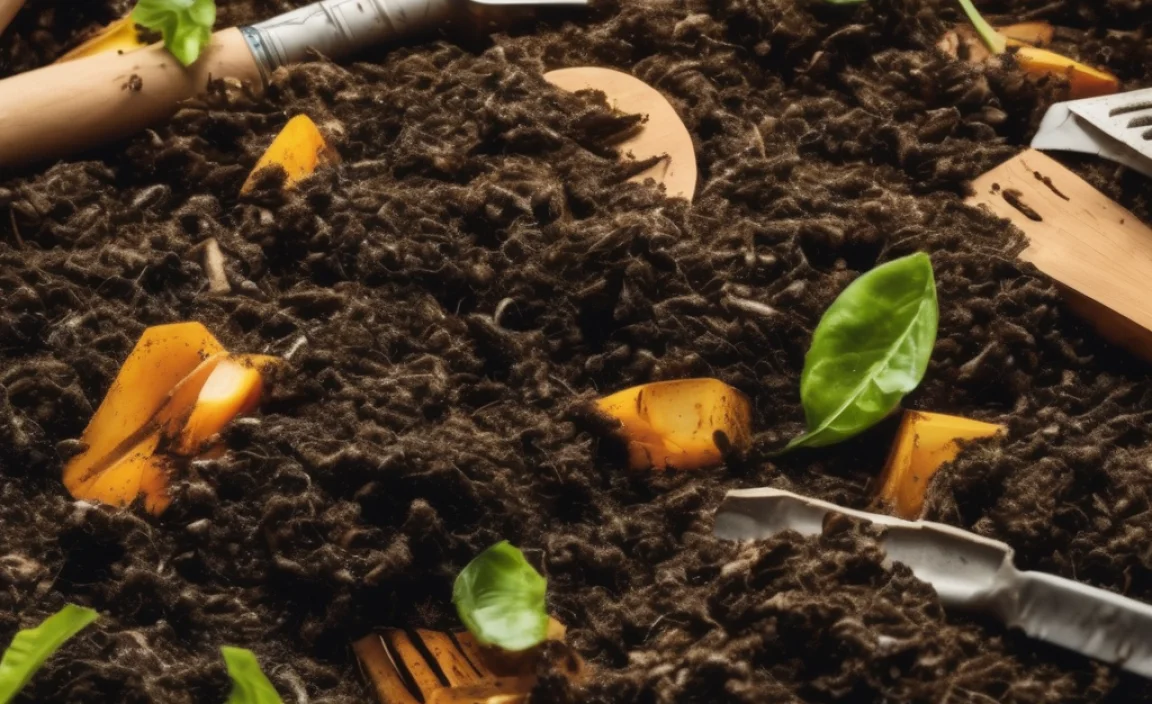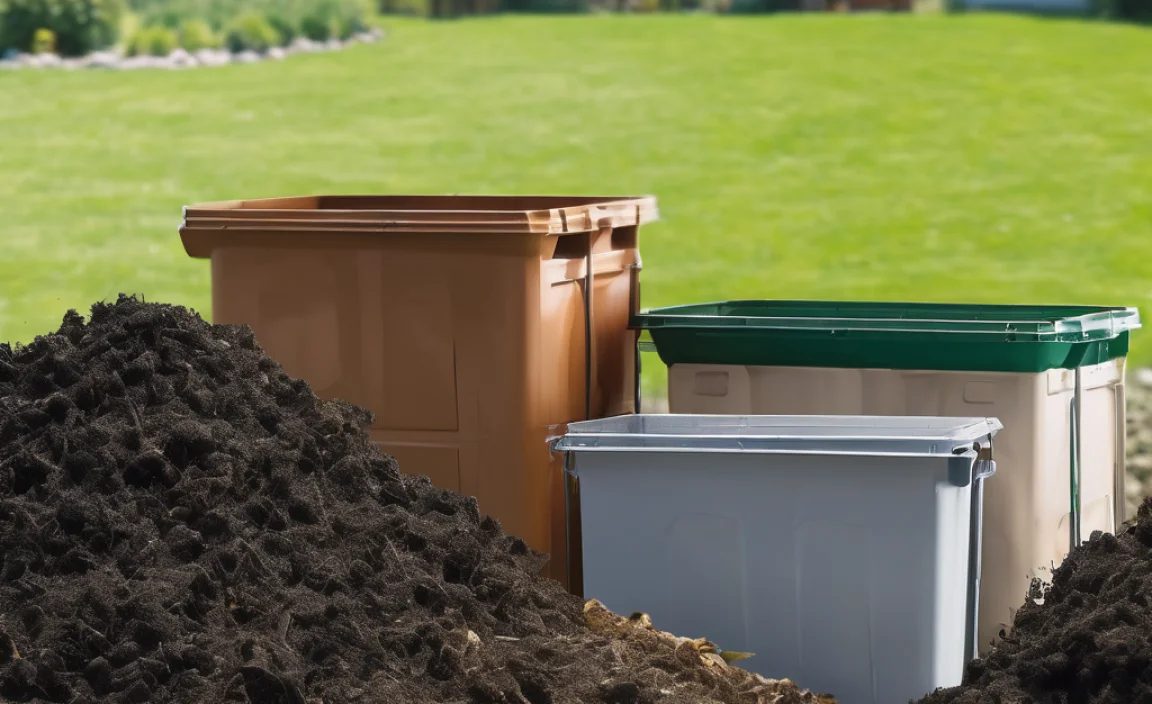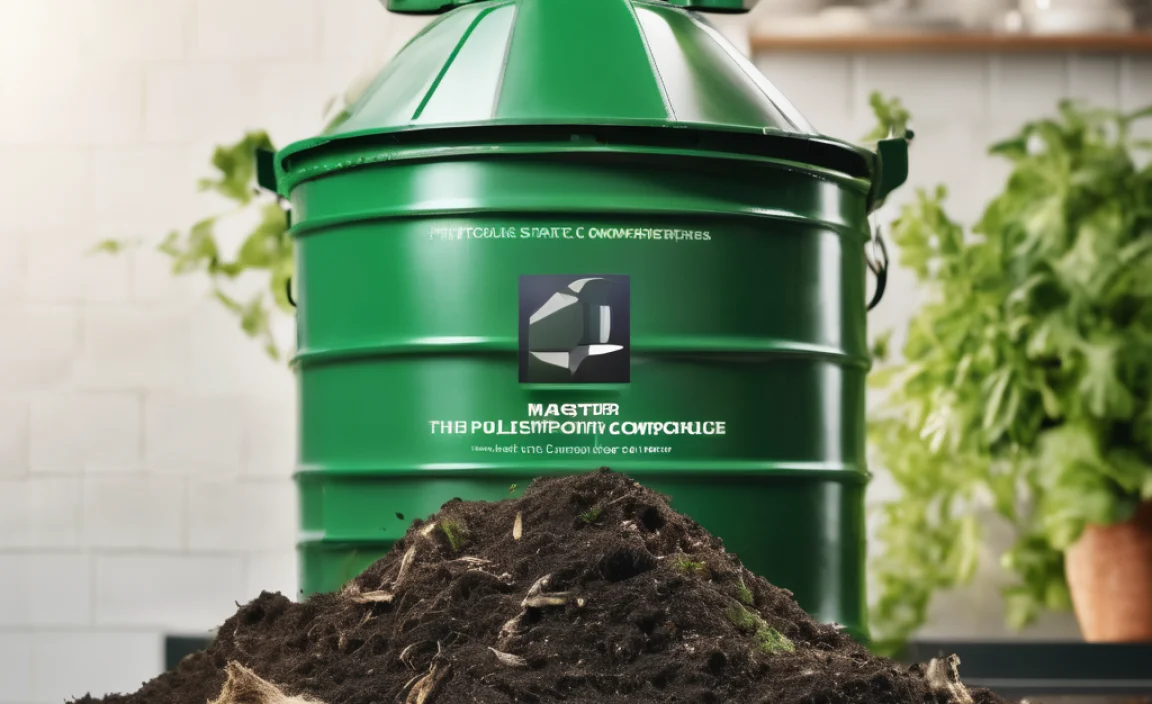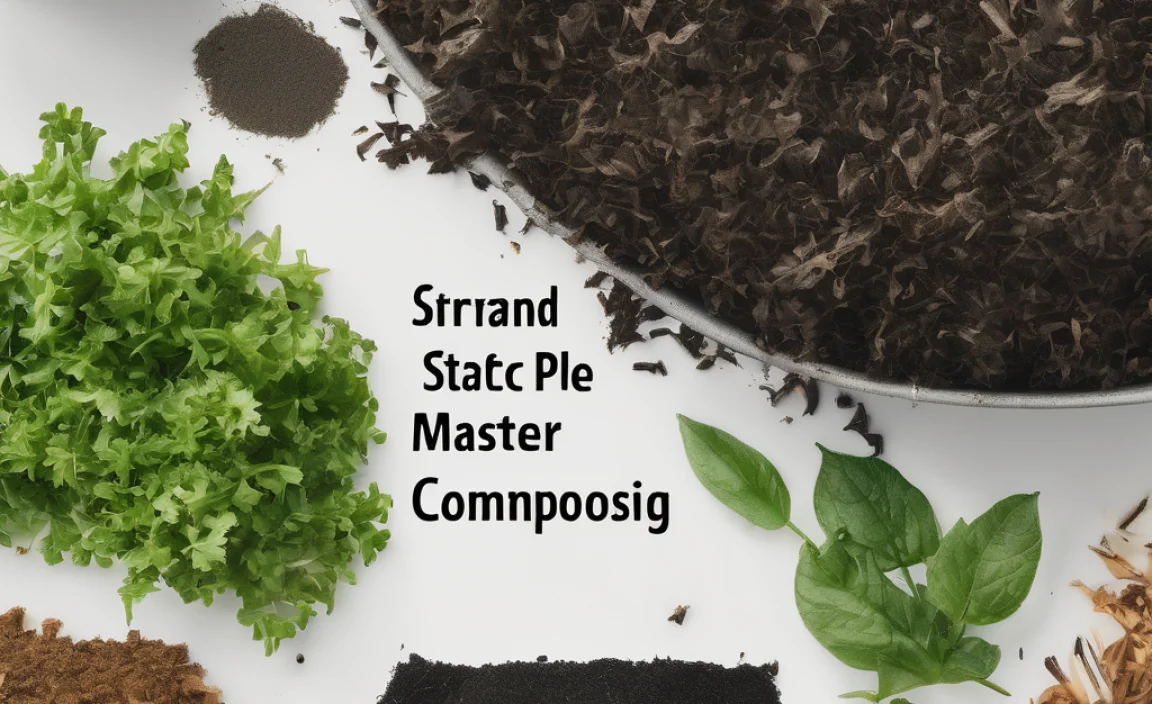Have you ever thought about turning kitchen scraps into rich soil? Static pile composting methods can help you do just that! Imagine a pile in your backyard that magically transforms food waste into garden gold. It sounds like a fairy tale, but it’s true. Static pile composting is a simple process that lets nature do the work. Let’s dive in and discover the secrets of static pile composting methods!
Key Takeaways
- Static pile composting turns waste into valuable soil.
- It is simple and requires little maintenance.
- Natural processes do most of the composting work.
- Helps reduce waste going to landfills.
- Static pile composting methods are great for beginners.
Understanding Static Pile Composting

Static pile composting involves making a pile of organic waste. This pile decomposes over time, turning into rich soil. Imagine a big pile of leaves, grass clippings, and food scraps. Over weeks and months, microorganisms break it down. You don’t need to turn or mix the pile often. It’s an easy way to start composting without much fuss. Just make sure you have a balance of green and brown materials.
- Green materials include fruit and veggie scraps.
- Brown materials are leaves and straw.
- Water helps keep the pile moist.
- Air allows microorganisms to breathe.
- Avoid adding meat or dairy to the pile.
- Place the pile in a sunny spot.
- Patience is key for this composting method.
With static pile composting, you let nature take its course. The microorganisms in the pile are like tiny workers. They break down the waste into compost. This process can take several months. Over time, you will see the pile shrink and change. If you’re patient, you’ll be rewarded with nutrient-rich compost. This compost can feed your garden plants, helping them grow strong and healthy.
Fun Fact or Stats : Bacteria in compost can generate heat up to 160°F!
Why Choose Static Pile Composting?
Why would someone pick static pile composting over other methods? Well, it’s one of the easiest ways to start composting. You don’t need fancy tools or special bins. Just pile up your organic waste and let nature do the rest. It’s a great way to reduce waste and help the environment. If you have a backyard, you have space for a static pile. This method fits well with busy schedules. It saves time, and you still get great compost.
Setting Up Your Compost Pile
Setting up a static pile is simple. First, pick a spot in your yard. Make sure it gets some sunlight. Next, start with a layer of brown materials, like dried leaves. Add a layer of green materials, such as vegetable scraps. Keep layering until the pile is about three feet high. Water each layer to keep it moist, but not soggy. This is important for microorganisms to thrive. Cover the pile with a tarp to keep moisture in. Then, let the magic begin!
What to Expect During Composting
What happens after you’ve set up your pile? During the first weeks, the microorganisms get to work. They start breaking down the materials. You might notice some heat and a slight earthy smell. Over months, the pile will shrink as compost forms. You don’t need to do much—just check the moisture and add water if needed. After about 6 to 12 months, your compost will be ready to use. You’ll have dark, crumbly soil to enrich your garden.
The Benefits of Static Pile Composting

Static pile composting methods offer many benefits. First, they help reduce household waste. Instead of tossing scraps in the trash, you turn them into something useful. This process also enriches your soil. Plants love compost because it’s full of nutrients. Your garden will grow better with this natural fertilizer. Plus, composting is good for the planet. It reduces the amount of waste that ends up in landfills. Less waste means less pollution and fewer greenhouse gases.
- Reduces kitchen waste going to landfills.
- Enriches garden soil naturally.
- Encourages healthy plant growth.
- Lessens environmental pollution.
- Promotes sustainable living habits.
- Easy for beginners to start.
- Requires minimal effort and tools.
Another benefit is that static pile composting is a great learning experience. Kids and adults alike can learn about the decomposition process. It’s fascinating to see how scraps transform into something valuable. This method of composting is also flexible. You can add to the pile as you generate more waste. It’s a continuous cycle that can keep your garden and the earth healthy.
Fun Fact or Stats : One ton of compost can reduce carbon emissions by up to 0.5 tons!
Saves Money on Garden Supplies
Did you know composting can save you money? Instead of buying expensive fertilizers, you make your own. Compost enriches soil naturally, so there’s no need for costly garden products. Your plants will thrive with homemade compost. It’s like giving them a superfood! This means less spending on plant food and soil conditioners. In the long run, you save money and reduce waste. It’s a win-win for you and the planet.
Makes Gardening Easier
Gardening becomes easier with static pile composting. Why? Because compost improves soil structure. This means better water retention and drainage. Roots grow more easily, and plants absorb nutrients faster. Healthy soil means less work for gardeners. You won’t need to water or fertilize as often. Your garden will be lush and vibrant with minimal effort. Composting helps nature help you, making gardening a breeze.
Encourages Biodiversity
Composting creates a tiny ecosystem in your backyard. This attracts beneficial insects and organisms. These creatures help break down compost and improve soil health. Birds and bugs that visit your pile bring joy and vibrancy to your garden. It’s like having a little wildlife sanctuary at home. When you compost, you support biodiversity. You create a healthy environment for plants and animals to thrive. You become part of a natural cycle that supports life.
How to Maintain a Static Pile

Keeping your static pile composting methods effective requires little effort. Yet, a few simple steps can make a big difference. First, check the moisture regularly. Your pile should feel like a damp sponge. If it’s too dry, add water. If it’s too wet, add more brown materials. Also, watch out for odors. If your pile smells bad, it might need more brown materials. Remember, the pile works best when it’s a mix of greens and browns.
- Check moisture levels often.
- Add water if the pile is dry.
- Add brown materials if it’s too wet.
- Mix greens and browns evenly.
- Cover the pile to trap heat and moisture.
- Keep an eye out for pests.
- Regularly check for a balanced mix.
Balancing the materials in your pile is like making a recipe. You need the right mix to get the best results. If you notice the pile isn’t breaking down, try adjusting the layers. Sometimes, turning the pile can help. Although not necessary, it speeds up the process. Static pile composting may seem slow at first. But with patience and a little care, it’s worth the wait.
Fun Fact or Stats : Compost piles can reduce waste volume by 50%!
Choosing the Right Materials
What materials work best in a static pile? Think about the scraps you produce daily. Vegetable peels, fruit rinds, and coffee grounds are great. Leaves, straw, and shredded paper are good brown materials. Avoid meat, dairy, and oily foods. These attract pests and cause odors. A good rule is to keep it simple and natural. If it grew in the ground, it’s likely safe to compost. Always aim for variety in your pile for the best results.
Dealing with Common Issues
What if things go wrong with your compost pile? Don’t worry; it’s normal to have a few hiccups. If the pile smells bad, it might be too wet. Add more dry brown materials like leaves. If it’s not breaking down, it might need more greens or moisture. Check the balance and adjust as needed. Sometimes pests, like fruit flies, can be a problem. Covering the pile or mixing it can help. Remember, composting is a learning process.
When to Harvest Your Compost
How do you know when your compost is ready? Finished compost looks dark and crumbly. It smells earthy, not rotten. This process can take 6 to 12 months. Patience is key! You can use a garden fork to check the pile. Dig into the center to see how it’s progressing. Once it’s ready, sift out large pieces that haven’t decomposed. Use the finished compost to enrich your garden soil. Your plants will thank you with healthy growth.
Comparing Composting Methods

How does static pile composting stack up against other methods? There are several ways to compost, each with pros and cons. Static piles are simple and require little work. They suit those who like a hands-off approach. Tumblers and bins require more effort but work faster. These methods need turning and careful monitoring. Vermicomposting uses worms to break down waste quickly. It’s great for small spaces but needs special care.
| Method | Effort Level | Time Required | Best For |
|---|---|---|---|
| Static Pile | Low | 6-12 months | Beginners |
| Tumbler | Medium | 3-6 months | Intermediate |
| Vermicomposting | High | 2-3 months | Advanced |
| Bin System | Medium | 4-6 months | Urban Areas |
Choosing the right method depends on your needs and lifestyle. Static pile composting methods are ideal for those who want minimal effort. If you have a busy schedule, it’s a great option. You can still make rich compost without much work. For those who want faster results, a tumbler or bin might be better. Vermicomposting is excellent for those interested in worm farming. Each method has its place in the composting world.
Fun Fact or Stats : Around 30% of household waste can be composted!
Choosing the Best Method for You
Which composting method fits your lifestyle? If you want simplicity, static piles are perfect. They require less work and are easy for beginners. If space is limited, bins or vermicomposting might be better. Consider your time and resources. Do you have time to turn a tumbler regularly? Or do you prefer letting nature take its slow course? Think about these factors when you choose. Remember, any composting is better than none.
Mixing Methods for Best Results
Can you mix composting methods? Yes, you can! Some people use a combination of static piles and tumblers. Start with a static pile, then move older materials to a tumbler for faster results. This way, you enjoy the ease of a static pile and the speed of a tumbler. Mixing methods can provide rich compost year-round. Experiment and find what works best for your garden and schedule. The goal is to make composting easy and rewarding.
Learning from Others’ Experiences
Want to know more about composting? Connect with others who compost. Share tips and learn from each other’s experiences. Many communities have composting groups or workshops. These are great places to ask questions and find solutions. Online forums and videos are also helpful. Seeing how others compost can inspire and motivate you. You’ll discover new ideas and methods to try. Remember, composting is a journey. The more you learn, the better you’ll get!
Conclusion
Static pile composting methods offer a simple way to turn waste into treasure. They require little effort and deliver big rewards. Whether you’re a beginner or have little time, this method fits well. By composting, you help the planet and improve your garden. It’s a win-win for everyone. So, why not start your own compost pile today? With patience and care, you’ll soon have rich soil for your plants.
FAQs
Question: What is static pile composting?
Answer: Static pile composting is a method that involves letting organic waste decompose in a pile. It requires little maintenance and relies on natural processes. It’s ideal for beginners because it doesn’t need regular turning.
Question: How long does static pile composting take?
Answer: Static pile composting usually takes between 6 to 12 months. The time depends on factors like climate, materials, and pile maintenance. The process is slower than other methods because it requires less intervention.
Question: What can I compost in a static pile?
Answer: You can compost fruit and vegetable scraps, coffee grounds, and brown materials like leaves. Avoid composting meat, dairy, and oily foods. These can attract pests and create odors. Balance green and brown materials for best results.
Question: Does static pile composting smell?
Answer: When done correctly, static pile composting should not smell bad. If the pile smells, it might be too wet or need more brown materials. Ensure proper balance and airflow to prevent odors.
Question: What are the benefits of static pile composting?
Answer: Static pile composting reduces household waste and enriches garden soil. It requires little effort and helps the environment by reducing landfill waste. It’s also a great way to learn about natural decomposition processes.
Question: Can I compost in winter using static pile methods?
Answer: Yes, you can continue composting in winter. The process slows down in cold weather but doesn’t stop. Covering the pile helps retain heat and moisture. In spring, the process will speed up again.
